 By Pepper Parr By Pepper Parr
October 25th, 2020
BURLINGTON, ON
Mayor Marianne Meed Ward has a regular television show on the Cogeco cable network.
Cogeco provides the free time as one of the conditions attached to their license.
Late in September the Mayor and Ward 3 Councillor Rory Nisan took part in a virtual conversation with Curt Benson, the Regional planner about the Nelson Aggregate application for new licenses to continue open pit mining for aggregate needed for the concrete used in construction for everything from high rise towers to sidewalks in the city.
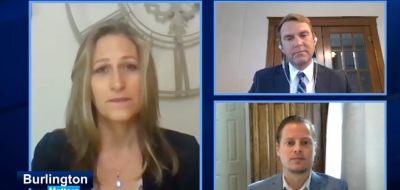 Mayor Meed Ward, Councillor Rory Nisan (lower right) and Regional Planner Curt Benson on the Cogeco cablecast. There is considerable opposition to the license applications from people who live in the rural part of the city.
The process and level of public involvement is complex and involves five levels of government and agencies.
The Mayor had Benson take her through the process that would be used. It is complex and time consuming and will take at least two years before they are anywhere near a decision. A municipal election will have taken place before the issue is ready for a decision.
Burlington’s city council is one of the bodies that makes a decision but it is the Niagara Escarpment Commission (NEC) that has the clout. If they decide the granting of licenses is not in the public interest and does not meet with the NEC mandate there will be no license.
The provincial Ministry is the body that will actually issue the license.
At this point in time the focus is ongoing through the thousands of pages of documents that were submitted with the application. It will take a couple of years for this to be completed.
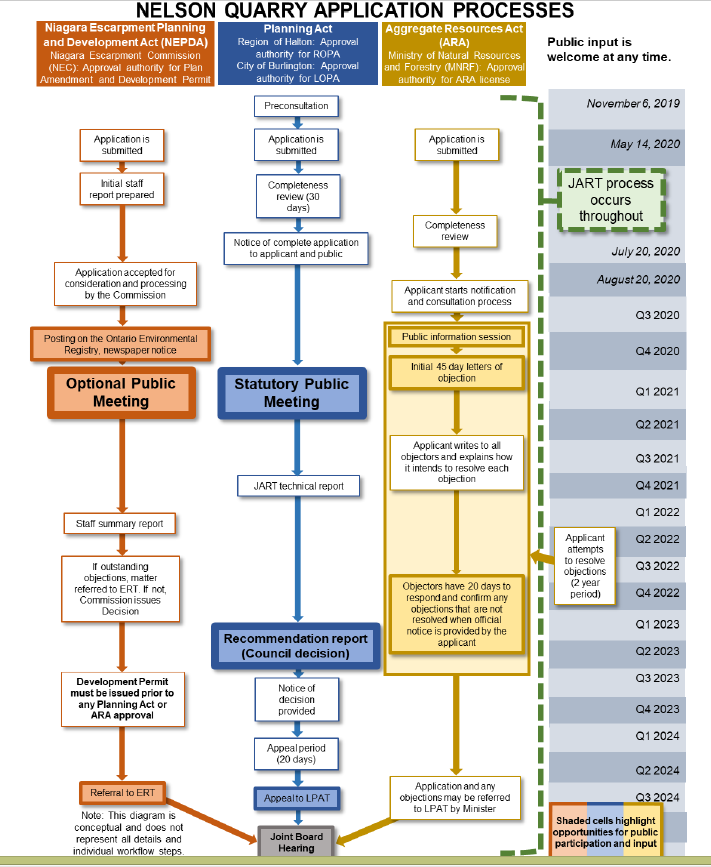 There are a lot of hoops for the application to get through before this gets to a decision point. During the half hour broadcast Meed Ward and Nisan talked about community involvement, protection of the environment and the interests of the citizens – especially those who live in rural Burlington. Ward 3 covers the North West part of the city and while the population is not all that large – they certainly have clout.
Meed Ward and Nisan want to be able to say that they have done their best to save rural Burlington. They are half way through their first term of office and can be expected to shift the shape of the way they see things and move into election mode.
As elected officials they are not in place to focus on just the immediate and short term interests but the longer term interests of the city.
And that is where Meed Ward and Nisan failed miserably.
Neither made any mention of the offer to turn the mined out properties over to the city to be used as a public park.
Meed Ward did say that the area did have a park – she was referring to the Cedar Springs Golf Club – private and expensive.
Much mention was made of the community group that is opposed to future development of the open pit mines – little mention of the citizen’s group that would like to see a park created out of the land once the aggregate is mined out.
Spencer Smith Park and the Beachway are packed on the weekends when the weather is good.
The Conservation Authority is now charging a fee to enter their parks and limiting the amount of time you can spend there.
Lowville Park, a destination for large family gatherings, now meters the number of vehicles that can be in the park and limits the amount of time people can stay – which puts a real damper on family groups that often spend the best part of a day in what is a very nice park.
If there are limits now on where people can enjoy the outdoors what will Burlington do when they have added 15,000 to 20,000 people to its population by the time the quarry is ready to be closed?
The long range look is part of a city Councillor’s job – a Mayor is expected to take a long term view and to prepare the public for what is coming and to make the best of an opportunity.
The public didn’t see much of that when the Mayor dragged the Regional Planner into the fray.
Benson was pretty good at keeping his distance by being the professional he is – he was not about to be co-opted by a Mayor.
Nelson Aggregates may be talking to the wrong level of government. The Conservation Authority operates the Mt Nemo property which is a couple of football field lengths away from the quarry. They would be more suited to operating any park that might be developed in the future.
More on this in the weeks ahead.
Salt with Pepper is the musings, reflections and opinions of the publisher of the Burlington Gazette, an online newspaper that was formed in 2010 and is a member of the National Newsmedia Council.
Related new stories:
Citizens organize to oppose quarry expansion
Nelson Aggregates releases plan to turn quarry into parkland

 By Pepper Parr By Pepper Parr
October 23rd, 2020
BURLINGTON, ON
For most of us it’s a Friday, another weekend where there are more restrictions than things to do.
But for most of the members of city council Friday matters. Marianne Meed Ward was elected Mayor, Angelo Bentivegna, Kelvin Galbraith, Rory Nisan, Lisa Kearns and Shawna Stolte were elected to council for the first time.

Paul Sharman was re-elected – he wasn’t certain that he was going to pull it off – but he did.
 Minutes before the Chain of Office was placed on her shoulders in December of 2018 Meed Ward has certainly made her mark during this first two years as Mayor. She has and is moving the needle.
The Gazette will report in depth on how each of the newly elected have done now that they are at the half way point and their minds get turned to re-election or deciding that being a council member isn’t everything they thought it was going to be.
It is certainly a harder job than any of the five new members thought it was going to be.
Some have grown into the job, for others it’s clear they shouldn’t be there.
There have been some surprises – the job is clearly a calling for them.
COVID-19 hasn’t helped these people adjust to the job. There is still a little trying to figure out just what they can do and what they can’t do as members of Council when a lot of the decision making is in the hands of the City Manager and senior staff.
This Friday the five newbies deserve congratulations – they have worked hard; they have struggled and they are learning.
Mayor Meed Ward is, for the most part, doing what she said she would do. There are parts of her promise she may not be able to keep but it won’t be for lack of trying.
Like the five newbies she is adjusting to a role she has thirsted for, fought for and won.
Much to her chagrin she has found that some of her colleagues are not looking to her for the leadership she would like to provide. In the municipal world the Mayor is just one vote with a bully pulpit along with some bling.
The money is decent, more than most of the members of this council have ever earned in their lives.
The newbies have power; they can make things happen.
Power often does funny things to people; it tends to eat into whatever humility they had before they took the oath.
Salt with Pepper is the musings, reflections and opinions of the publisher of the Burlington Gazette, an online newspaper that was formed in 2010 and is a member of the National Newsmedia Council.

By Michele Bogle
October 21st, 2020
BURLINGTON, ONTARIO
Originating in Ontario in 1992, two of Turtle Jack’s franchised locations are conveniently located at either end of Burlington. One located at the Mapleview Mall at Maple Ave and Fairview St; and the other at Appleby and Ironstone giving you the convenience of not having to travel far to this popular fine-dining eatery.
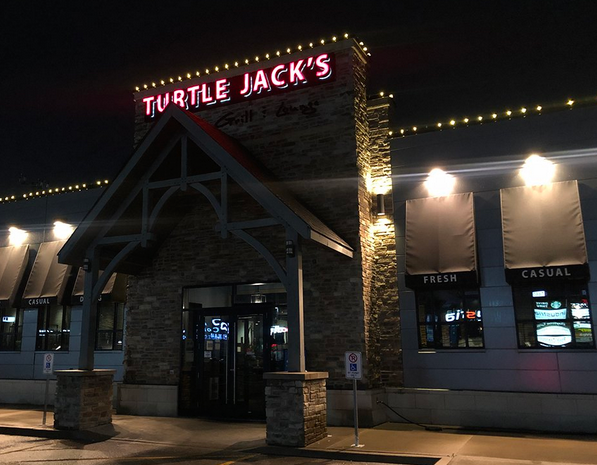 This may be a chain of commercial restaurants but it doesn’t compromise when it comes to quality food and flavours. The decor is trendy and lighting is low for a stylish, yet inviting setting. This may be a chain of commercial restaurants but it doesn’t compromise when it comes to quality food and flavours. The decor is trendy and lighting is low for a stylish, yet inviting setting.
Of course, everyone donned a mask, both staff and patrons – evident when entering. There are direction markers on the floor in an effort to avoid close contact while moving within the restaurant. Much of their seating are booths and cannot be moved; temporary plexiglass partitions were erected in between them. No reservation is required for small groups when contact information is typically gathered, but rather it’s collected, at the door. Standard practices seemed to be in place; the tables weren’t pre-set.
Although it was a Saturday night, there was no evidence that the Appleby location was suffering from a decline in patronage. At 6:30 Turtle Jack’s was at full capacity, adhering to the new guidelines of safely spaced seating, and a two metre spaced lineup developed at the door.
There was a family of ‘energetic’ people with resounding voices seated near to us. The General Manager asked if we were at all bothered. Another time my answer may have been different, but today I was quite happy to hear the sounds of ‘life’ in an otherwise quieted environment of late.
Even having looked ahead at the Pre-Fixe Taste of Burlington Menu for Turtle Jack’s, I was still undecided when I arrived. Their three course menu choices, exclusive to this dining event, all looked entirely too delicious to pick just one from each course offered. I really wanted to try the ‘Seafood Chowder’, therefore reluctantly eliminated the blackened bass from my entree choice. My son chose the ‘4 Cheese Cajun Chicken Penne’, so I knew that I’d get to sample a little; and happily landed on the steak.
 I really wanted to try the Seafood Chowder – it did not disappoint. The seafood chowder has a blend of flavours that hits your palate in the most delightful way. While just the right serving size as an appetizer, it left me wanting more.
 Steak that passed my touch test. My family, well aware that I avoid ordering steak anywhere because of the exhausting disappointment expressed when the temperature of my steak is wrong. I had noticed them shoot one of those glances that expressed concern over my choice. I hadn’t ordered steak in some time and after tasting the well-balanced blend of flavours in the chowder, I thought I’d give this restaurant the heavy task of impressing me.
The presentation for me, is a great part of the sensory preparation for what is about to be enjoyed. On paper, I had ordered steak and potatoes. Quite straight forward. The plating of my “Certified Angus Beef 8OZ Top Sirloin” was 5-star quality. On my plate was a pillow of fluffy mashed potatoes with just the right amount of salt added; crisp sauteed green beans and mushrooms; then in the centre a perfectly-sized steak with a medium-rare cook that I just knew by looking, as well gestured with great approval when doing the finger touch and it sprung back; adorned with evenly cut, buttermilk-dipped onion strings. It’s quite easy to destroy a steak.
My tastebuds rejoiced at the ‘sight’ of this dish. When the General Manager came around to ask how everything was, I was quite pleased to respond with, “perfect’ followed by the sounds of my family unanimously exhaling, then resuming their conversation. The seasonings worked well together. I thoroughly enjoyed this dish.
 Cheese Cajun Chicken Penne The ‘4 Cheese Cajun Chicken Penne’ is always going to be a palate-pleaser if you’re a cheese lover. The combination of cheeses: Asiago, mozzarella, cheddar and feta produced a very satisfying flavour combination. What was remarkable to me was the presence of cheddar that I could taste. It usually takes a back seat to the other flavourful cheeses, but I loved it! It was made with quality Barilla pasta; complemented with a tender piece of blackened chicken.
 Heavenly brownie covered w/ a layer of caramel & chocolate caramel mousse. We moved on to the dessert, all of us ordering the ‘Turtle Pie’. Here is the restaurant’s description: “Heavenly brownie covered w/a layer of caramel & chocolate caramel mousse. Sprinkled w/walnuts & chocolate flakes.” First of all, the plating was beautiful. This dessert isn’t at all brownie-like. What I tasted was a slice of chocolate mousse that was exquisitely silky smooth, not too sweet. The drizzle of caramel was the right amount to complement this dessert. While the sprinkling of walnut pieces was present, I was captivated by the silkiness of the mousse.
During the course of the time spent at Turtle Jack’s, we had gaps when our server wasn’t present and would have made mention while there if it wasn’t for the General Manager who filled in those moments when we were looking for service, in a timely manner. I have never dined at Turtle Jack’s before last night, but I’d return. I give the food ‘3-thumbs up’.
For more information on the Pre-Fixe menu options during this dining event that ends on October 25, 2020, please check the Taste of Burlington website for more details. https://tasteofburlington.ca/prix-fixe-program/. Remember to sign up for the Taste of Burlington Passport to make menu selections from the app, paperless. The more you check-in from the app, the more chances you have of winning the weekly gift certificate giveaway and eligible for the grand prize of a $500 gift card to a restaurant of choice. This is useful for family gatherings now that the holidays are approaching.
Turtle Jack’s
1900 Appleby Line , Burlington, L7L 6A1
289-288-0390
OR
Turtle Jack’s
900 Maple Avenue Mapleview Centre, Burlington, L7L 6A1
289-288-0484
 Michele Bogle is a Burlington resident who writes for the Gazette on community issues. Ms Bogle has taken part in the Food Network for the second year in a row to audition for the ‘Great Chocolate Showdown’ 2020 and 2021. She made it to the second stage of auditions for ‘Wall of Chefs’ 2019 and finished top 1% of auditions last year for ‘The Great Canadian Baking Show’. Michele Bogle is a Burlington resident who writes for the Gazette on community issues. Ms Bogle has taken part in the Food Network for the second year in a row to audition for the ‘Great Chocolate Showdown’ 2020 and 2021. She made it to the second stage of auditions for ‘Wall of Chefs’ 2019 and finished top 1% of auditions last year for ‘The Great Canadian Baking Show’.

By Michele Bogle
October 20, 2020
BURLINGTON, ONTARIO
 Without going into an extended history lesson on Neapolitan Cuisine, suffice it to note that its cuisine took much from the culinary traditions of Naples, Italy; reaching a balance between dishes based on rural ingredients (pasta, vegetables, cheese) and seafood dishes (fish, crustaceans, mollusks). Fortunately for us this tradition was brought to our very own Village Square by the Paradiso Restaurant Group in 2003, after great success opening the first Paradiso Restaurant in Oakville, in 1993. This Mediterranean gem has impressed guests since its inception. Tripadvisor rates it #10 out of more than 300 restaurants in Burlington and snagged a #2 spot on the top 10 best Italian restaurants in Burlington, by Yelp. Without going into an extended history lesson on Neapolitan Cuisine, suffice it to note that its cuisine took much from the culinary traditions of Naples, Italy; reaching a balance between dishes based on rural ingredients (pasta, vegetables, cheese) and seafood dishes (fish, crustaceans, mollusks). Fortunately for us this tradition was brought to our very own Village Square by the Paradiso Restaurant Group in 2003, after great success opening the first Paradiso Restaurant in Oakville, in 1993. This Mediterranean gem has impressed guests since its inception. Tripadvisor rates it #10 out of more than 300 restaurants in Burlington and snagged a #2 spot on the top 10 best Italian restaurants in Burlington, by Yelp.
Taking part in the Taste of Burlington’s Fall Dining Pre-Fixe menu, we ordered the butternut squash soup; soup-of-the-day, and the ‘Baked Brie’ as our dinner appetizers. While we waited, freshly baked fragrant bread with tomato and carrot incorporated in it, among other seasonings, was placed before us to enjoy.
 Combined with a little extra nutmeg and cumin I believe that I tasted caramelized onion in a lighter than usual base. I’m constantly amazed at how squash soup can be modified and recreated to have the varieties of flavours that it has. This soup was again quite different in appearance. My curiosity peaked when I saw the colour cast of Paradiso’s butternut squash soup and had to taste some. Combined with a little extra nutmeg and cumin I believe that I tasted caramelized onion in a lighter than usual base. Quite delicious. I had ordered the Brie – a very generous serving of baked brie, wrapped in honey basted phyllo; paired with crostinis and a sweet tomato jam.
While there were several delectable choices, I thought that it made the most sense to try Paradiso’s signature pasta dish; Crab Ravioli. The description found online; Goat cheese stuffed ravioli, rock crab, tomatoes, chiffonade spinach, spicy basil cream sauce, says it all.
The flavours of each of these individual elements were present. I found myself scraping the bowl for final remnants of the not-too-spice cream sauce at the end.
Don’t be fooled by the portion size of the dessert offered. Flourless cakes are known for being extremely dense. This cake didn’t disappoint. The chocolate was a perfect compliment to the end of the meal. I couldn’t have eaten another bite.
 The chocolate was a perfect compliment to the end of the meal. The restaurant exercised the standard safety practices; face masks, table spacing, tables were not preset, sanitization station. Nothing extra to report. Our server was friendly, attentive, knowledgeable about the menu as well as the ingredients used. The music was a mixture of oldies with current hits, low enough to allow for comfortable conversation. I would dine here again.
Support your local hospitality; Paradiso does as evidenced on their social media platforms.
Paradiso Restaurant
2041 Pine Street, Burlington, L7R 2L8
905-639-1176
For more information on the Pre-Fixe menu options during this dining event that ends on October 25, 2020, please check the Taste of Burlington website for more details. https://tasteofburlington.ca/prix-fixe-program/.
Remember to sign up for the Taste of Burlington Passport to make menu selections from the app, paperless. The more you check-in from the app, the more chances you have of winning the weekly gift certificate giveaway and eligible for the grand prize of a $500 gift card to a restaurant of choice. This is useful for family gatherings now that the holidays are approaching.
 Michele Bogle is a Burlington resident who writes for the Gazette on community issues. Ms Bogle has taken part in the Food Network for the second year in a row to audition for the ‘Great Chocolate Showdown’ 2020 and 2021. She made it to the second stage of auditions for ‘Wall of Chefs’ 2019 and finished top 1% of auditions last year for ‘The Great Canadian Baking Show’. Michele Bogle is a Burlington resident who writes for the Gazette on community issues. Ms Bogle has taken part in the Food Network for the second year in a row to audition for the ‘Great Chocolate Showdown’ 2020 and 2021. She made it to the second stage of auditions for ‘Wall of Chefs’ 2019 and finished top 1% of auditions last year for ‘The Great Canadian Baking Show’.

 By Ray Rivers By Ray Rivers
October 21st, 2020
BURLINGTON, ON
COVID 19 is helping to reshape our political world. Nowhere was that better seen than in the re-election of New Zealand’s young prime minister, who has led her country and shown the world how to deal with the coronavirus. She was rewarded by the voters with a landslide victory and a first ever parliamentary majority since New Zealand adopted proportional government back in the 1990’s.
By contrast there is the US presidential race and if Trump loses, which appears likely, it will be because of his mishandling of the pandemic. Americans are constantly reminded of the quarter million folks who have died under his watch, despite his assurances that the virus was just a flu and would be gone by last May.
 Jacinda Ardern, Prime Minister of New Zealand Jacinda Ardern is a very talented leader who built a coalition with the Green Party on the left and the NZ First on the right and ably governed to the respect of New Zealanders during the devastating global pandemic. But unlike Canada, New Zealand was prepared for the pandemic and it acted swiftly to contain and eliminate the virus months ago.
There have been the inevitable outbreaks since then, a consequence of allowing returning nationals into the country, but they have been contained by contact tracing and mandatory quarantine. Like Canada, New Zealand closed its borders, but it did so much earlier and avoided much of the initial spread we allowed.
Being a unitary state it was easier, no doubt, to effect a consistent national health care policy. That was also true for the early lock down rules which kept people from spreading the virus. New Zealand is an Island but the virus arrived there as it did here – by airline passengers, so that is no excuse for Canada’s much poorer performance.
 New Zealanders are now able to attend sports events and concerts – the Covid19 virus New Zealand’s success can be attributed to its viable and consistent plan which was followed and enforced until the virus was gone in addition to a compliant population who followed the rules and a strong and visionary leader, of course. Today there are only a few active cases remaining – all of which are contained and under quarantine. Meanwhile the rest of the country has gone back to normal. The shops and businesses have re-opened and even crowded sporting events are back.
Masks are no longer required, even on public transport.
The New Zealand economy has taken a hit, along with just about every nation on the planet. International tourism makes up a large portion of the country’s economy. And since the airports are mostly closed to non-citizens, domestic tourism is being promoted to help keep that business sector going.
New Zealand should be a model for how other nations deal with the epidemic and protect their populations. But it is not the only model. Uruguay, another small nation, bordered by Brazil and Argentina, both of which have significant contagions, has done remarkably well. Taiwan with a population five times that of New Zealand has suffered only 7 deaths. And both Uruguay and Taiwan have come through without a lock down so far.
And then there is China, where the virus originated, but which managed to virtually eliminate it in short order and has dealt effectively with the inevitable periodic outbreaks related to foreign travel. But unlike most other nations China’s economy is showing a marked rebound and life is mostly going back to normal.
 Day after day Doug Ford, Premier of Ontario goes before the TV cameras to explain the most recent decision on combating Covid19 So what about Canada? Canada’s focus has always been on ‘Flattening’ rather than ‘Eliminating’ the curve. So when the provincial lock downs had been successful in flattening the infection curve we got carried away with our success, declaring victory and opening up the economy so people could mingle and spread the disease again. We did ask people to wear masks and distance, but the messages were mixed and the test/tracing practices unsuccessful. As sure as night follows day the contagion got a second wind.
Bringing the infection rate down will be much harder this time. Schools are open, cold weather has pushed people inside where the virus is where it wants to be, and we’re COVID fatigued, tired of it all. We’re sick and tired of the restrictions, and the steady stream of bad statistics, and the daily media briefings, and the mixed messages from our politicians, and the economic malaise, and the ever-rising debt we’ll have to reconcile one day.
So perhaps next time our leaders will take a lesson from nations, like new Zealand, which have been successful in overcoming this contagion the first time. And if they do perhaps political rewards, like one kind Jacinda Ardern has just been given, will be in their future as well.
Background links:
Jacinda – New Zealand Gets IT– China Gets It –
 Ray Rivers, born in Ontario earned an economics degree at the University of Western Ontario and a Master’s degree in economics at the University of Ottawa. His 25 year stint with the federal government included time with Environment, Fisheries and Oceans, Agriculture and the Post office. Rivers is active in his community, Ray Rivers, born in Ontario earned an economics degree at the University of Western Ontario and a Master’s degree in economics at the University of Ottawa. His 25 year stint with the federal government included time with Environment, Fisheries and Oceans, Agriculture and the Post office. Rivers is active in his community,

Michele Bogle
October 15, 2020
BURLINGTON, ONTARIO
Barra Fion’s Pre-Fixe Taste of Burlington menu boasts seven appetizers and five delicious-sounding entrees to choose from. With such a fantastic selection, it took us longer than anticipated to decide.
This Spanish inspired tapas restaurant was well spaced with plexi-glass shields in between the tables set in the middle of the room to allow for additional and safer seating. The best part was the non-contact facial recognition temperature scanning at the entrance. Our servers were patient, knowledgeable about the menu, and engaging. The restaurant was clean and guests wore masks while moving within the restaurant. As a reminder; using the Taste of Burlington Passport App also allows you to read menus digitally to avoid paper contact.
 Jumbo Lump Crab Cakes For starters we tried the ‘Jumbo Lump Crab Cakes’. Two, only, may not sound like a generous portion but they were considerably large, hearty, flavourful and the aioli sauce was addictive, as well a perfect compliment to the dish.
 Blackened Shrimp and Farro Mediterranean Salad We had also ordered the ‘Blackened Shrimp and Farro Mediterranean Salad.
This dish overloaded my senses. A culinary delight which was visually intriguing with all of its elements. Each ingredient with a specific purpose; a little crunch, a little spice and a little zing. I highly recommend this item on the menu.
 Spanish Inspired Seafood Stew Delightfully perplexed by my choice for the next course, we happily landed on ‘Spanish Inspired Seafood Stew’ as our entree. Don’t let the uninspired name fool you. This dish was a whole new eating adventure with its individual elements. The perfectly spiced blackened tilapia needed to be experienced first before dropping into the delicious seafood broth below; held up by a generous number of mussels and surrounded by a medley of stewed vegetables and herbs. Within the broth were found large gorgeous shrimp and an almost serrated roll of calamari. In my mind the garlic bread was provided to enjoy the delicious broth with. I was still echoing an “mmm, mmm, mmm” as I placed my empty bowl to the side.
 Pumpkin Spiced Mini Churros For dessert, my daughter and I chose the ‘Pumpkin Spiced Mini Churros’ with caramel sauce. I think that the chef forgot that they were supposed to be minis. Shhh, it’ll be our little secret. Adding a touch of pumpkin spice to an already perfect dessert is ‘brilliant’.
I thoroughly enjoyed my visit to Barra Fion and would recommend that if you haven’t yet experienced their food, that the pre-fixe menu offered during the Taste of Burlington Dining Event is a perfect time to try different items on their menu at an excellent price.
Please note that this event runs only until October 25. You won’t want to miss it. Some restaurants are giving out additional offers. The more you use the Passport App to check-in when you dine at one of the participating restaurants, the more chance you have of winning the weekly gift-card giveaway and the grand prize of a $500 gift card to a restaurant of choice.
Barra Fion is located at;
1505 Guelph Line, Unit 10A
Burlington, ON L7P 3B6
905-319-3466
Open 7 days a week, 12-9pm
 Michele Bogle is a Burlington resident who writes for the Gazette on community issues. Ms Bogle has taken part in the Food Network for the second year in a row to audition for the ‘Great Chocolate Showdown’ 2020 and 2021. She made it to the second stage of auditions for ‘Wall of Chefs’ 2019 and finished top 1% of auditions last year for ‘The Great Canadian Baking Show’. Michele Bogle is a Burlington resident who writes for the Gazette on community issues. Ms Bogle has taken part in the Food Network for the second year in a row to audition for the ‘Great Chocolate Showdown’ 2020 and 2021. She made it to the second stage of auditions for ‘Wall of Chefs’ 2019 and finished top 1% of auditions last year for ‘The Great Canadian Baking Show’.

 By Lawson Hunter By Lawson Hunter
October 10th, 2020
BURLINGTON, ON
As Council knows, public engagement is near and dear to my heart. I’ve spoken about community education, a wider approach to give citizens the opportunity to comment on policies and plans, and I’ve proposed various methods of having community voices heard – in particular – citizens’ assemblies.
I respectfully ask that Councillors search out information on how Citizens’ Assemblies work and how they are successfully being used around the world.
Fortunately, I have the time to attend Standing Committee and Council meetings being held during the day. Many in our community cannot afford to take time off to participate.
I attended one of the Citizen Action Labs, have spoken to several ex-members of Citizen Advisory Committees, attended a few of those committee meetings as a silent observer, and read the various documents, staff reports, committee minutes and the recommendations from the Citizens Advisory Committee Review Team. As you know, I go in for the deep dive.
As public engagement goes, I look at what the City has done with regard to the Adopted Official Plan and the ‘Take a Closer Look Downtown’ initiative as the gold standard. Dozens of opportunities, countless interactions, volumes of documents to pour over, many, many Get Involved messages, even walking tours and town halls.
Compare that to the City’s outreach for the Advisory Committee Review. Three Action Labs, an online survey and a questionnaire at an outdoor market. All done over a year ago. Yes, there was a citizens Review Team that, I presume, worked diligently to interpret the responses heard. But there was no opportunity to respond to the document that they produced.
Basically, a year has passed and silence. If nothing screams Public Engagement – in ALL CAPITAL LETTERS – it’s the Advisory Committee structure. Something that the public has been complaining about for over 20 years.
Then, on Sept. 17th up pops a staff report with a phased in approach and a request from the Corporate Services CSSRAC committee to start recruiting Advisory Committee members.
Which to my mind, means that we’ve gone back to the status quo while the Clerk’s office works out the details.
So here’s my request. Hit the pause button for a few more months. We’ve all been distracted by COVID. Parents are struggling how to send their kids to school and keep their families safe. Operations at City Hall has morphed into a giant Zoom call. Council is about to be swallowed up with the City’s 2021 Budget. Business owners are fighting to keep their doors open. And more and more people have lost their jobs, and are lining up at Food Banks and COVID testing sites.
Is this the time to start recruiting for Advisory Committees? We’ve gone seven months without them. What harm would another few months do?
Hit the pause button and give this staff report, and some details, to those people who spent their time attending the Action Labs, who bothered to fill out the surveys, who sit or have sat on previous Advisory committees, the Engagement Charter and Shape Burlington.
Give us a chance to review what’s being proposed. One last chance to make a suggestion or comment. A bit more time to decide whether or not we want to sign up for a committee, or decide to let others take over.
That would be Public Engagement, the kind that we deserve here in Burlington.

 By Staff By Staff
October 8th, 2020
BURLINGTON, ON
In the days before Covid, a delegation would be sitting in the Council Chamber, often amongst their peers.
You would be called up when it was your turn and you would address the members of council. On many occasions there would be questions from the members of Council which at times got quite frothy.
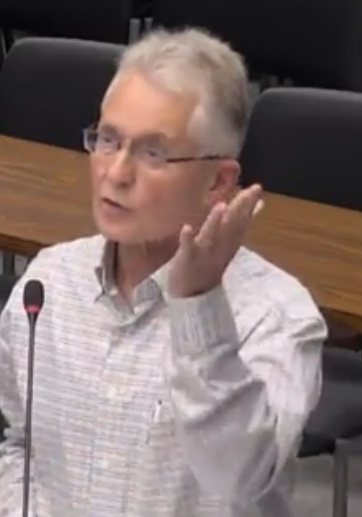 Gary Scobie delegating. The public doesn’t get this kind of performance anymore – and we are the poorer for it. I recall an occasion when Gary Scobie was delegating – and when it came to questions he was able to give as good as he got. That was during the days of the 2014-2018 council
A regular Gazette reader wanted to delegate on an issue that concerned him.
The Agenda for the meeting (and accompanying application form to delegate) was not online until Thursday afternoon. Our reader was busy until 7pm.
He filled out application form at 7am on Friday (to meet the deadline of noon the next day – weekends don’t count – for Monday’s Council meeting)
Friday morning – he was busy on a community matter.
Friday 4pm – open emails to find a note from Clerk’s department which read:
“I have received your request to delegate at City Council on September 28, 2020. Due to COVID-19, all requests to delegate must contain a copy of the delegate’s intended remarks which will be circulated to all Members of Council/Standing Committee in advance of the meeting as a back-up to any technology issues that may occur.
“Once I receive your delegation comments I will confirm your delegation.”
This was new to our reader.
 The first of four images sent by the city to the delegator. He is a quick writer but commented that there was no way he could prepare anything reasonable in 30 minutes. So I wrote something, anything, over the weekend and sent it in.
As a back-up he emailed his Councillor ask him to intervene just in case there was a hiccup – there wasn’t.
Sunday 7:20PM Clerks office emails, got your remarks, you’re good to go.
Monday 1pm – into the Delegates Room. Was asked in the instructions sent to me to “open my video (thought about it but decided not to).
 The second of four images sent to the delegator When it came to my turn to delegate and I was facing a screen with 15 little people staring back at me (council and staff). Just as well I didn’t open my video, I spent the whole time looking down to read.
Seeing the Councillors is also a new feature. Last time (one month ago) my screen displayed what you see at home “Delegate Speaking”. So when I did look up, it was a bit unnerving, and everyone’s face was too small to read reactions.
The “rooms” we are placed in are all virtual.
There was a virtual Room shared by the people getting ready to delegate and then a separate virtual room for people who were about to actually delegate.
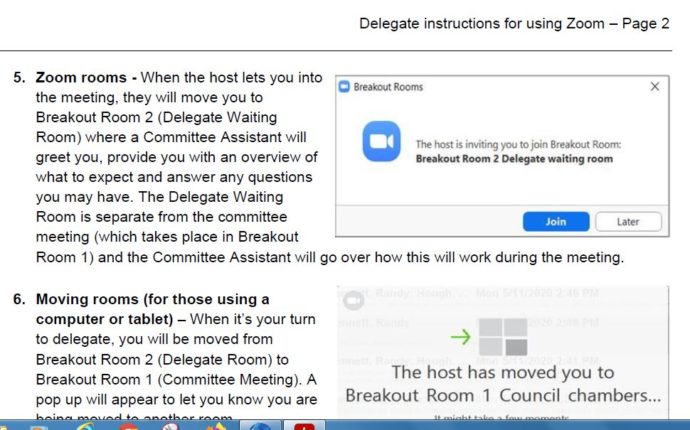 The third image sent to the delegator Everything I did was from the comfort of my home in Aldershot.
I was first in what was referred to as the delegate room where I could look at a screen and see who the other people waiting to delegate were.
When it was my turn I was moved (again virtually) to were it was me and the members of Council along with whichever Staff members were taking part.
All I could see where the 20 or so people taking part – all set out before me on a computer screen.
When a particular person was speaking a yellow box was placed around their picture so I didn’t have to look all over the place for the speaker.
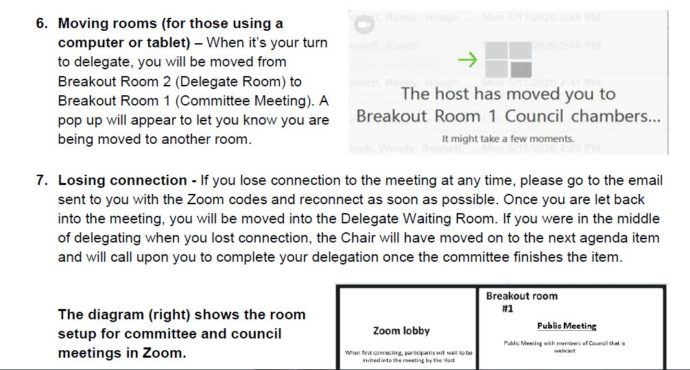 The fourth image sent to the delegator. Was it a satisfying experience? It certainly wasn’t the kind of experience that one had when they stood at the podium before council.
The request to send in the paper I was going to read from was offensive – the Council members were not going to reads my document; many of them have problems getting through the staff reports.
Is this the best the city can do in terms of giving the citizens a way to say their piece?
Could the technology not allow for something better.
To the person at home watching the event – there is something unreal; almost plastic. The public never gets to see the person delegating – which is possible with the technology being used. The city has chosen not to do that.
It is also possible to see the embers of Council when they are speaking. The image is not always that good – but at least it is an image.
Regional Council shows everyone taking part in a meeting.
It seems to be the best that can be done at this point.
The tradition of citizens delegating will be lost if the current Zoom process is all that is going to be available.
People don’t like the current process and are not comfortable with it.
We consistently get comments from readers saying they do not feel respected by members of Council. This was certainly the case with the 2014-18 council. Does it apply to the current council? Too early to make that call – but we are seeing dis-satisfaction galore with the on-line learning students who went the virtual route are getting and have every reason to believe that the same concern exists with the Council delegations.
We will look for some time to see what other municipal council’s are doing and report back.
A member of this council is going to have to take a stand and insist that something better be put in place.
Right now this council is fixated on telling each other how well everything is going.

October 4th, 2020
Last week Council endorsed the recommendations from the Planning department on the Scoped Review of the Downtown Core portion of the adopted but not approved Official Plan.
The endorsement goes to Council this week and, if approved, will be come part of the Official Plan that is currently in the process of being revised. It will be sent to the Regional government where it has to be approved.
Citizens created an organization they called We Love Burlington, (WLB). That group released the following statement related to an article the Gazette wrote on the decision of Council to endorse what the planners had brought forward.
The WLB statement should be part of the public record.
Last December and January, WLB delegated before City Council opposing the direction proposed in the returned Official Plan for downtown development and the public waterfront. We were joined in our opposition by our colleague, Gary Scobie, long time civic activist and critic. Today we post a submission by two members of WLB and Gary on the virtually unchanged but ‘final’ direction for downtown and the waterfront. We continue to advocate for local voice and respectfully request that it be heard. If you agree, contact your Councillor and make your voice count. We strongly suggest looking carefully at the morass of documents and not simply the consultant’s Guidelines nor the summaries provided by the City or council members.
September 21, 2020
The following is the joint submission of Lynn Crosby and Blair Smith, two founding members of WeLoveBurlington, and Gary Scobie, long-time civic activist and advocate. We share a common passion for the City of Burlington and a common purpose in protecting its downtown and waterfront from inappropriate development and excessive intensification. We also have a compelling interest in preserving the integrity of local government – that level of governance closest to the citizen and most sensitive to local needs and voice. Indeed, WLB actually was created by the need to counter the provincial direction for amalgamation at the regional government level. The campaign, waged in concert by a number of ad hoc organizations, was ultimately successful and the threat of amalgamation in Halton removed.
Ironically, the government that WLB fought to preserve because of its perceived sympathy to the people’s will, then turned a virtual deaf ear to many of those citizens when it developed its revised plans for Burlington’s downtown. It would appear that proximity to the people is no guarantee of either the ability to hear their voice or follow their wishes.
On December 5th, 2019 and January 12th, 2020, we delegated before Council. On those occasions we questioned the timing and basic process of the course that brought forward the 243-page Integrated Control By-Law Land Use report and the highly interdependent 319-page Preliminary Preferred Concept Report. We challenged the timing, the conclusions and the basic sequencing of events. At that time, we urged Council to address the relocation of the Urban Growth Centre (UGC) and the mis-designation of the John Street bus station and the downtown as a Major Transit Station Area (MTSA). We argued that these actions must be a priority before any acceptable redesign of the downtown was possible. We asked for ‘no more tall buildings’. And we were not heard. Indeed, with our final delegations there was not one question posed. We raised inconvenient truths and there was no will to exchange ideas, no appetite to debate. We were politely but conclusively dismissed. We determined at that time that further delegation was pointless and the course for downtown irrevocably charted.
Today, however, we are making another statement in response to the latest documents, the Placemaking and Urban Design Guidelines and the Downtown Burlington Fiscal Impact Analysis and the latest, and apparently final, version of Report PL-16-20, Taking a Closer Look at the Downtown Recommended Modifications to the OP. We do this to bring orderly closure to our advocacy and, once again, echo the voice of Burlington citizens who deserve to be but have not been heard. Sadly, the situation remains almost exactly the same as it was nine months ago – all this time spent tinkering with the documents, but not substantially changing the position or the “vision.”
On page 8 of the Guidelines, for example, the two designations that enable both the Province and the development community to force high intensity massing of people and/or jobs in Burlington’s downtown remain unchanged and in force. We refer, of course, to the Urban Growth Centre (UGC) and the Major Transit Station Area (MTSA). COB recently announced that Council voted unanimously on August 24, 2020 to request removal of these designations, yet they remain the key component of the downtown OP, the Guidelines, all Schedules and the Fiscal Impact Analysis. Coupled with this is the fact that LPAT, the ‘new’ dispute forum, is a high-rise developer’s dream tribunal where height and massing in designated growth areas are not just supported but are actively encouraged.
The Urban Growth Centre (UGC) designation was first applied to our Downtown through the Places to Grow provincial legislation in 2005 and ratified by Burlington Council in fall 2006, just weeks before the City Election. It demanded a minimum 200 people/jobs per hectare over the area bounded by the Growth Centre and remains in place today.
The Major Transit Station Area designation arrived much later in the second decade of this century through the provincial agency, Metrolinx, based on the unsubstantiated claim that our Downtown Bus Terminal qualified as a Mobility Hub. The MTSA covers roughly the same area as the UGC and requires the same intensification minimums. Both designations support high intensity massing of people/jobs (and buildings) in the Downtown area and reinforce each other as provincial intensification tools. Moreover, both designations share three critical aspects detrimental to the popular “vision” of what constitutes “good planning” for Burlington’s downtown:
The intensification applies over an area, not a building.
There is no maximum stated. Only a minimum is demanded, and municipalities are “encouraged” to go above the minimum.
There is no mention in the legislation of maximum building height – the sky is quite literally the limit.
So, the two most damaging factors remain unchanged and will be ‘in force’ and operative for the foreseeable future – at minimum, until the Regional Official Plan is revised and approved. This factor alone undermines the comforting assurances and lofty principles of the Guidelines. Indeed, the latter are almost a misdirection, intended to appease a skeptical and fatigued citizenry; false guarantees that intensification can be controlled and made amenable to the public will. But, as Guidelines, they exist simply to articulate what “should be” not what “must be” and they can be contravened by any number of higher policies and direction statements. For example, the “Core Commitment: Downtown Vision and Action Plan” (as amended) goes beyond and takes precedence over the “Placemaking and Urban Design Guidelines”.
In essence, the Guidelines are unenforceable, part of an array of reports and documentation that requires a very informed and patient reader to do all the necessary cross-referencing to determine the complete context. As with the past process of last December and January, the documents are too numerous, too dense, too intricate and too complex. They are not intended to easily inform.
Truly, the devil can be in the details. There are instances in which the Guidelines don’t match or conform to the main OP report. One of the best examples is Village Square. The Guidelines talk about 4 storeys “abutting Martha Street” but Village Square, as popularly known, does not extend to Martha Street.
The Guidelines state:
“1. The maximum height of developments abutting Martha Street shall be 4 storeys and/or shall provide a built form transition to Martha Street and north of Pine Street to maintain the existing low-rise character.”
2. Retail frontages should be designed to complement and reinforce the unique human scaled and historic character of the Village Square Precinct.
3. Retail provided at-grade along Pine Street will act as a transaction to the Village Square development and emphasize an intimate relationship with the public realm by providing a minimum setback of 4 metres from the curb.
4. Development should maintain and enhance views of the Village Square.”
The language is intended to give the impression that the low-rise nature of the area is being protected and preserved. However, when the map (notably, only included in the revised schedules and omitted from the Guidelines) is referenced, it is clear that the north portion of Village Square allows 11 storeys. Moreover, both the Report and the Guidelines are silent on the treatment of the Square’s interior. At best this is misleading; at worst, a deliberate omission. And this is characteristic of the Guidelines as a whole. They contain a treasure trove of vague, ambiguous, qualitative language that provides a sense of affirmation but does not allow for measurement or objective validation.
The Guidelines perpetuate a number of known problems and deficiencies already cited with the planning process and the downtown modifications made to the Official Plan. Most glaring, perhaps, is the fact that the Old Lakeshore Road precinct continues to be ignored. Why is this most critical of precincts, the gateway to the downtown, continually out of scope?
Why are the serious issues, constraints and challenges posed not openly addressed? Why reference it as one of the 10 precincts and note that the downtown is “on a beautiful waterfront setting”, then completely ignore what is required to protect the waterfront, enhance its accessibility to the public and maintain the existing views? Indeed, Burlington has had a very uneven record over the last 20 years in terms of preserving and protecting the natural asset of the waterfront. It sold valuable waterfront property to private owners, failed to extend the waterfront trail and allowed development interests to prevail over those of public access. These Guidelines and this Official Plan do little to reverse the mistakes of the past. World class cities provide strict and enforceable measures to ensure that their waterfronts are valued as irreplaceable jewels and true public assets. Burlington, by contrast, posits a “feel good” set of principles (pp 44/45) factored around the discretionary preservation of “views” and “access”.
The same principles with the same poor expectation of effective implementation are used to preserve sight lines to landmark buildings such as City Hall, Knox Presbyterian Church and Village Square. One can reasonably argue that the view of City Hall will be obstructed by the Twin Towers approved for the northeast and southeast corners of Brant and James. Knox is located in the Downtown East Precinct that allows tall buildings and is vulnerable to demolition. Village Square presents a series of already identified issues. In fact, we take serious issue with the whole Downtown East Precinct in which the “precedent” of existing tall buildings is used to justify an ongoing ‘tall building’ development pattern. Why is the “precedent” not anchored in the many one or two storey houses in the area? How does the allowance for 17 storeys on Elizabeth Street and 17 at the Lions Club Park conform to the existing adjacent neighbourhoods? How does it conform to that which the people have been asking and how is it feasible that that small area around tiny Martha Street and Lakeshore/James could possibly accommodate this many tall buildings and additional congestion? Where is the requirement that Carriage Gate finally, after more than a decade, build their promised parking garage and medical centre at the site of their 17-storey condo building atop a three storey “podium” (the much-touted retail portion on ground level still completely vacant) located in the East Precinct? Why is the consultant/staff recommending 22 storeys at the Carriage Gate property at Pearl and Lakeshore, beside the uniformly unwanted ADI property next door?
There is almost a complete lack of green space and amenities. The map in Schedule 3, Appendix D shows three green circles denoting “public parks” (viz. Ghent/Brant, No Frills parking lot and Martha near New Street). They are small, located in insignificant areas and appear as afterthoughts – not integral components of the plan. The City claims to want to create complete communities with all of the amenities, but this worthy goal appears to have been abandoned in the downtown. Indeed, there is no section in the Guidelines dealing with green spaces and parks. Instead of needed amenities, community hubs and actual parkland, we are presented with the concept of POPS (Privately Owned Publicly Accessible Spaces) as leisure and recreational areas for the thousands of people who will populate the new buildings. The POPS were featured in the Fall 2019/Winter 2020 presentations of the preferred concepts for downtown. They were not critically acclaimed then and deserve no better treatment now. In fact, little has changed with either the concepts or the consultant’s treatment of the design for downtown. So, for example, where is the recognition that the pandemic has dramatically changed our reality? In the Fiscal Impact Analysis:
“Table 3-1 summarizes the residential growth projections for Downtown Burlington to 2031. It is anticipated that the within Downtown Burlington, the City’s population will grow by 2,787 population over the 2020-2031 forecast period. The population growth will be facilitated by the development of 1,720 additional high-density residential dwelling units. Consistent with the assumptions of the 2016 FIS, it is assumed that 75% of high-density residential development will be in the form of condominium development, with the remaining 25% comprising apartment developments.”
Remarkably, there is no updated view of the changes that COVID has made to our lives and the nature of our future living. Today, and for the foreseeable future, there is far less desire for condominium living and cloistered spaces. People want to distance and separate, want more open spaces and houses with traditional features and backyards. Accordingly, there should be fewer allowances for tall buildings and much better-defined planning for open spaces. Why is the consultant’s vision unchanged?
This speaks to our final major issue – the implicit cynicism of the consultation process and the lack of meaningful public engagement. Much has been made by the City and Council in ward newsletters and social media posts of the extensive outreach that has been undertaken. Citizens have been thanked for their time and effort reviewing an endless array of documents, helping to make the Official Plan and its policies a better, more inclusive work. However, nothing has materially changed. The preferred concepts, the vision and principles, the Official Plan itself with its myriad ancillary reports and the strategic documents ‘ad infinitum’ have not been varied or amended. The direction has not been moderated by either public comment and feedback or influenced by a differing public perception. The development scenario was essentially set during last Summer and Fall, when SGL Consulting was engaged under a directed tender to validate staff-defined outcomes. The necessary substantiating reports and studies were then concluded with predictable findings and the path forward unaltered from that framed and established at the very beginning.
Neither Council nor Planning staff should believe that a lack of new comments opposing much of these final documents means that the public now finds them acceptable. In the midst of a pandemic and at the end of a very long, quite protracted and overly tiresome process with too many documents, too many cross-references and too many versions, people are fatigued with the need for repetition; for saying repeatedly what they want and never being heard. We know that the council members are there to speak up on our behalf, convey our long-standing and unchanged positions, and to direct staff as they see fit. This is what the public expects and is counting on.
In summary, we’ve been here before – several times actually and nothing substantive has changed. It’s not that we expect that Council is under any obligation to passively comply simply because we attended and delegated. However, we did expect to be respected and to be heard. We represent a popular voice to which you have turned a deaf ear; worse, to which you have claimed an avid attention, then done nothing. We respectfully request that you provide for substantive amendments to the Official Plan, addressing the deficiencies noted in this submission and reflecting what the people of Burlington want for their downtown.
We understand that Council has worked with staff on modifications to produce a revised Official Plan for endorsement but we believe that it is seriously flawed. It leaves the waterfront vulnerable to development and permits a downtown in which tall buildings will dominate, with no real green space or public amenities. As we have said from the beginning, there is only one waterfront and one downtown – once gone there will be no bringing anything back and we urge the current Council, elected with such high popular expectation two years ago, to do everything needed to clearly ensure their permanent protection. Your legacy depends on it.

 By Ray Rivers By Ray Rivers
October 3rd, 2020
BURLINGTON, ON
Haven’t we seen this movie before? The eagerness to open up the economy before the virus was properly contained has returned us to where we were back half a year ago. In fact worse. We have already exceeded the record of infections we saw last spring. Does that mean the long months of lock down were all in vain?
Who is running this ship anyway ? Dare I say… this was, of course, entirely predictable. And now we’re expected to top 1000 cases in a of couple weeks. But we really have no idea, since the virus is exponential and there are lags between exposure and symptoms… and well… who knows?
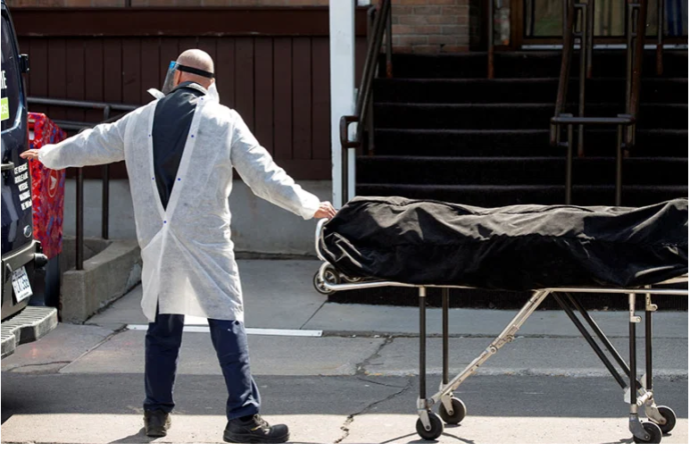 Infections have reached 1000 a day in Quebec. Deaths have also increased. Quebec has already beat us to the 1000 cases a day, by the way. Yet it was barely three months ago that Premier Legault was so convinced he’d beat the virus to the ground that he opened up provincial restaurants and bars and invited customers in – Bon Appétit. And now he has had to shut them all down.
Earlier this week on the very day that Ontario hit its highest level of infections ever, 700 cases, casinos in the province were allowed to reopen. And still the Premier thinks he is smarter than the virus – that he can outmaneuver it, surgically control it, micro-mange and fine tune how we live our lives to constrain it – rather than doing what his neighbouring province has had to do.
We are all waiting for a vaccine to save us – something we expect to have by early next year. So one has to ask – why not sit tight and wait? Oh sure we need money to live by – but the feds have the printing presses primed – and most of us are doing better than ever if we consider the amazing growth we’ve seen in personal savings.
COVID is the viral disease making all this fuss, but this is also an economic and social crisis of historical importance.
Provincial gross domestic product (GDP) suffered its greatest loss ever. This is entirely attributable to measures we’ve taken to flatten the curve (of infections). And were it not for the federal government doling out cash we’d be in big trouble. Ontario lost over a million jobs during the June to August period.
 Restaurants are taking the biggest hit – and there doesn’t appear to b a solution for them in the near term. While just about every sector had been affected by the epidemic, entertainment, travel and hospitality were the hardest hit. These are the business activities where viral spread is hardest to control. Hospitality and tourism make up about 4% of provincial GDP generating over $22 billion in sales in a normal year. Together with restaurants there are over 11,000 establishments across the province.
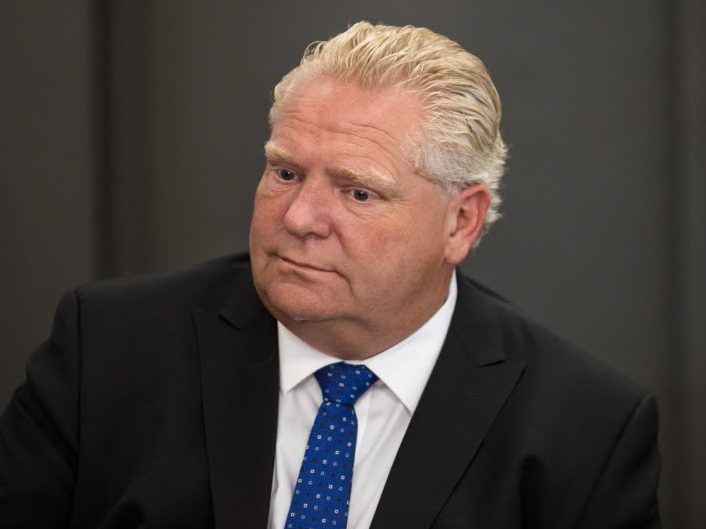 If the virus gets even worse, the Premier knows he’ll have no choice but to lock them down again. And that is the dilemma facing the Premier. If the virus gets even worse, he knows he’ll have no choice but to lock them down again – when hospitals get overloaded and more seniors start dying he won’t be able to pretend that his surgical blade can do the impossible. He’s already getting flack from health experts demanding more lockdown and that he fire his chief medical officer.
It’s not easy being a man without a plan. And it’s clear the Premier is making it up as he goes along. Every new daily briefing brings some new direction, which may conflict with the one from the previous day. And while he can predict we’ll have a thousand new cases a day by mid-October, he can’t tell you what we’ll be doing about it.
And the mixed messaging is not only causing confusion but also social unrest. There have already been some protests over masking. And we see normal law abiding folks, who mostly observed the earlier restrictions on public and private gatherings choosing to ignore them now. Indeed when Ford himself ignores his own rules as he has done on occasion – why not? He is supposed to set an example, after all.
 The public reaches a point where they don’t want to co-operate. Civil rights organizations have also taken up the question of the constitutionality of lockdowns, restrictions and bubbles – though the courts so far have weighed on the side of public interest over individual rights. But if protesters can demonstrate that government is not doing a good job at protecting them anyway – that may all change.
And there is a lot of evidence. Accountability for failure to protect the lives of long term care residents, by actions before and after the lockdowns is still on the back burner. Failure to prepare for the safe re-opening of schools. The inconsistency of restrictions. Inability to successfully execute a test and trace program. And of course the decision to re-open the economy when the Premier anticipated increased case loads as a result.
But the premier has to weigh the economic benefits of allowing these sectors to remain open against the potential economic consequences of another major lock down. He has to worry about employment and GDP and the provincial budget deficit which is forecast to hit some $40 billion, but likely will be much higher.
And of course there is scheduled to be a provincial election at the beginning of June 2022. After all, for a man claiming to be a deficit killer and opposed to tax increases and raising more debt, he is faced with tumbling provincial revenues and hugely increased provincial expenditures. And then there is the matter of the health of the all the people.
 The vaccine may not turn out to be the solution – despite the amount being spent. As we wait for a solution to the epidemic, either a viable vaccine or for the virus to miraculously die off on its own, as SARS did, the Premier has to balance the health and lives of Ontario folks against the economic costs of coping with the economic fallout from the virus.
So the question is whether his surgical talents will successfully constrain the contagion – or whether we are headed for a deja vu.
 Ray Rivers writes regularly on both federal and provincial matters as well as environmental issues. He has degrees in economics and was the founder of the Sustainability Advisory Committee in Burlington. Rivers was a candidate for provincial office in Burlington where he ran against Cam Jackson in 1995, the year Mike Harris and the Common Sense Revolution swept the province. Ray Rivers writes regularly on both federal and provincial matters as well as environmental issues. He has degrees in economics and was the founder of the Sustainability Advisory Committee in Burlington. Rivers was a candidate for provincial office in Burlington where he ran against Cam Jackson in 1995, the year Mike Harris and the Common Sense Revolution swept the province.
Background links:
Mixed Messages – Ontario Peaks – Testing –
Australia vs Sweden – Long Term Care –
More Long Term Care – Savings Rate – Ontario Job Loss –
Confusion – Ontario Deficit –

 By George Wolfson By George Wolfson
September 30th, 2020
BURLINGTON, ON
The majority of gambling platforms allow users to play both for real money and free games. However, the winnings can be obtained only when playing for real money (with the possibility of their further withdrawal to a card or online wallet).
 The majority of gambling platforms allow users to play both for real money and free games. To increase your chances of receiving such a prize, it is worth listening to helpful advice from experienced professionals. If you are just starting your way in gambling, then you should pay attention to the no deposit bonus and the conditions to win without investing your money.
What Is No Deposit Bonus?
This reward is one of the casino promos that provides players with cash when they open an account or try a new game without replenishing it. In fact, there are not too many places where you can get real money with no deposit So, these bonuses offer a great opportunity to try a new casino or new game with minimal risk.
Gambling platforms may offer two types of such rewards:
1. Cashable: they allow the player to withdraw both the bonus money provided and the winnings;
2. Non-cashable: they cannot be withdrawn, because the casino deducts it from the total winnings.
The main purpose of such gifts is to advertise the brand, as well as quickly increase a client base. Usually, gambling platforms use no deposit bonuses in order to attract new customers or reward regular players.
 Understand the pros and cons of using no deposit bonus gambling – then have fun. Thanks to this offer, players can try something new without risking their own money. Online casinos can also provide free rewards on any new game so that visitors can play it and only then replenish the account.
Pros and Cons of Using No Deposit Bonuses
It should be noted that everything has its positive and negative sides, and all types of free rewards as well. So let’s pay attention to the pros and cons of using no deposit bonuses:
Advantages:
1. Having used these rewards, you will be able to study the whole functionality of the site and make sure that it is worth your trust;
2. You will be able to test the game in the real money mode and understand the principle of its work;
3. The player does not spend his own money and, as a result, he does not have to invest his own funds, if something is wrong with a casino.
Disadvantages:
● Small size. If you think that casinos are giving hundreds of dollars, then you are wrong. Usually, the reward starts from $10-20 free dollars to several dozens of free spins;
● The original bonus will not be allowed to withdraw immediately after the receipt. The withdrawal option appears only after playing a wager;
● These rewards are issued for a small number of games. As a rule, the use of free spins is limited to one or a few video slots.
Having considered the pros and cons of using no deposit bonus, you are ready to start. Good luck!

 By Pepper Parr By Pepper Parr
September 28th, 2020
BURLINGTON, ON
OPINION
Last June Regan Russell was walking in front of a transport truck that was loaded with hogs that were being taken into the Fearmans slaughter house. The truck had stopped until protesters finished walking front of it; Regan Russell wasn’t able to get out of the way in time and was run over by the truck. She died at the scene.
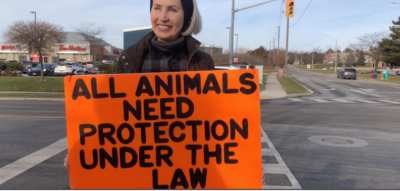 Regan Russell The slaughter house is part of a group of slaughter houses across the country that are owned by Sofina Foods.
Regan was one of a number of demonstrators who gather regularly at the Harvester Road/Appleby Line intersection to, as they put it, “bear witness to what is taking place” and to attempt to water the hogs.
They see what they are doing as a peaceful demonstration. They are indeed slowing down the entry of the truck into the meat processing plant.
Regan was run over by the truck that apparently didn’t see her. She was slight in stature and the front of the truck was very high.
The Regional Police investigated and came to the conclusion that a 28-year-old male from the Municipality of North Perth was to be charged with Careless Driving Causing Death under the Highway Traffic Act. The police reported that ‘there were no grounds to indicate this was an intentional act, or that a criminal offence had been committed.”
 The protesters usually arrive as a group waiting for the transport truck to enter the slaughterhouse. Animal Rights protesters have been demonstrating at that location for a number of years.
The meat processing plant, in operation since the 1960’s, has no intention of moving and currently employs 1000 people.
The provincial government recently passed legislation that would give the municipalities that have demonstrator problems “tools” to handle these situations.
The argument is that the issue is really one of public safety – they want the demonstrators out of the way.
Strong legislation certainly helps do that.
 Protestors water hogs when the transport has to stop for a traffic light at the entrance to the slaughterhouse. At the Monday City Council meeting a resolution was put forward and passed unanimously.
The Resolution reads:
Whereas the Security from Trespass and Protecting Food Safety Act, 2020 recognizes the unique risks that can result from interfering with livestock transport including creating unsafe work conditions as well as causing stress to animals and introducing diseases or contaminating our food supply; and
Whereas Sections 6(1), 7, 14(1) 3 and 15(1) of the Act came into effect on September 2, 2020 and prohibit the stopping, hindering, obstructing or otherwise interfering with a motor vehicle transporting farm animals; and
Whereas protest groups, including minor children, present outside the Sofina pork plant in Burlington continue to reach inside livestock trailers to touch, film and give water to the pigs creating an unsafe situation where they may be injured by the animals or trailer; and
Whereas the recent tragic loss of the life of a protester in Burlington underscores the urgent need to ensure the safety of all involved; and
Whereas Section 6(2) of the Act states that no person shall interfere or interact with a farm animal being transported by a motor vehicle without the prior consent of the driver of the motor vehicle;
Therefore be it resolved that the City of Burlington pass a resolution urging the Ontario Minister of Agriculture, Food and Rural Affairs to immediately proclaim Section 6(2) of the Act in order to provide a legal basis to prevent the unsafe practice of protestors having contact with livestock trailers and animals; and
That this resolution be forwarded to Ontario Minister of Agriculture, Food and Rural Affairs, the Association of Municipalities of Ontario and the Region of Halton.
Those in favour of the motion didn’t have a word to say about the right of people to protest.
 Hog suffering from heat while being transported. Councillor Sharman sounded more like a shill for Sofina Foods (they are in his ward) rather than a person responsible for the wider community. The puffball questions he asked the three delegations were embarrassing.
Which begs the question: Why not find a way to allow the Animal Rights people to demonstrate, maybe even water the hogs while the trucks wait at the gate for 10 minutes.
After which the demonstrators would be required to move on.
The Conservation Authority closes off a portion of Kind Road for weeks in the spring so that the Jefferson Salamander can cross the road and mate in the wetlands.
 He isn’t exactly pretty but nevertheless plays an important role in the local environment.
In 2008 a provincial tribunal found that the loss of a habitat for the Jefferson Salamander in north Burlington was reason enough not to give the Nelson Aggregate an extension to their license.
We have a proud history of protecting endangered species. Admittedly hogs are not endangered but the right of people to voice their views in a public place is as important as making huge allowances for an endangered species.
That history was sullied this morning by city council.
Related news story:
Protester run over by truck transporting pigs to slaughter.
Salt with Pepper is the musings, reflections and opinions of the publisher of the Burlington Gazette, an online newspaper that was formed in 2010 and is a member of the National Newsmedia Council.

 By Ray Rivers By Ray Rivers
September 25th, 2020
BURLINGTON, ON
OPINION
Part 2 of a 3 part series:
In 1976 the World Meteorological Organization warned of a very significant warming of global climate. In 1992 the UN held an Earth Summit in Rio in which climate change became the major topic. In 1997 the world agreed on the Kyoto Protocol, under which wealthier nations would commit to measured reductions and poorer nations would receive help to reduce theirs.
So what happened? Well, Bush and Harper pulled out of Kyoto and Trump is pulling out of the Paris agreement, the latest effort at global action. The oil industry, which had been studying and must have known the effects of their products on the earth’s climate since the 50’s, engaged in a massive dis-information campaign to challenge the science around global warming.
 This was the target – how are we doing so far? And the oil and gas sector, and their ideological entourage of right wing politicians, were successful. As late as 2015 less that half of all Americans believed that climate change was a serious problem and a year later they elected a bon fide climate change denier as president. The industry pulled a page out of the tobacco companies playbook for deception, denial and mis-information. Unlike the tobacco giants, however, they have yet to face their day in court.
Greenhouse gas (GHG) emissions for the most part are either carbon dioxide (CO2) or methane (natural gas). Methane is a very powerful GHG, upwards of 30 times more effective than CO2, but it is relatively short lived compared to CO2, which can last for hundreds of years.
Methane emissions can be natural as from wetlands, landfill and sewage facilities, melting permafrost, or released as a byproduct of farming from fertilizer or meat production
Methane emissions also come from the extraction, production and transportation of fossil fuels, primarily natural gas. And, along with coal and oil, total fossil fuels make up as much as three quarters of all greenhouse gases (GHG) emitted to the atmosphere. And since the industrial revolution we have increased the carbon in the atmosphere by 30% – an amount which has been increasing just about every year.
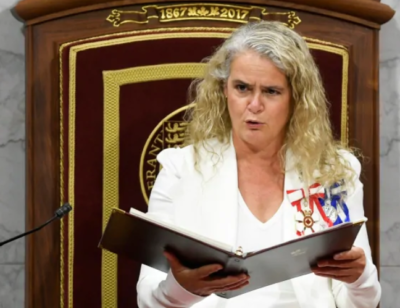 Gov. Gen. Julie Payette delivers the throne speech in the Senate chamber in Ottawa. So what are we doing about this now? On Wednesday the Governor General read a speech from the throne outlining the federal government’s aspirations and plans for legislation they will be introducing. The throne speech is directional, devoid of specific and detailed plans. And this speech for the most part was just a reiteration of last fall’s Liberal election campaign promises, but it made the point that attention to climate change will be one of the four cornerstones of Liberal policy going into the future.
The government promised to create thousands of jobs by retrofitting homes and buildings. It promised to make zero-emissions vehicles and public transit more affordable. It will maintain its carbon pricing policy, subject to a favourable Supreme Court ruling on it’s constitutionality. It will move to exceed its 2030 Paris emission goals. It will make meeting the goal of zero net carbon emissions by 2050 the law of the land.
There was a promise to make Canada a world leader in clean technology by launching a fund to attract new investments in zero-emissions products and cutting corporate taxes in half for those companies. The speech noted that Canada already has the natural resources needed for zero-emissions vehicles and batteries, such as nickel and copper.
A Clean Power Fund will connect surplus clean energy to regions that are transitioning away from coal. And the government will uphold campaign promises to ban single-use plastics by 2021, protect a quarter of Canada’s land and oceans in five years and plant two billion trees by 2029.
Energy was only mentioned twice and the government was almost silent on any goodies for the fossil fuel industry, a marked change from previous years. There was no mention however, that the feds will finally end the subsidies that flow to that sector – something they have been under pressure to do for at least a decade.
Will this be enough when it come to combating Canada’s contribution to climate change? Probably not, but it is the most forward looking set of environmental commitments since former PM Brian Mulroney championed sustainable development back in the late eighties. And unless the NDP or Bloc decide to support the government on the upcoming non-confidence vote we will all be in an election, just as we move into Canada’s second COVID wave.
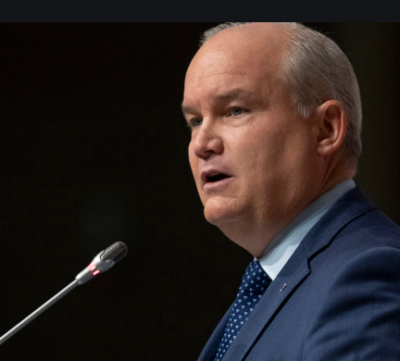 Leader of the Opposition in the House of Commons Erin O’Toole Currently COVID quarantined Conservative Leader O’Toole didn’t spell out his objections, other than mentioning his concern with the prospective price tag. And there is no way he can politically support a program which doesn’t promise more oil extraction and pipelines for the west. Much like former PM Harper and leader Scheer, he is captive to the fossil fuel barons and their supporters in Alberta and Saskatchewan.
Trudeau noted that electric vehicles and their batteries will soon be manufactured in Canada, primarily at Ford in Oakville and Windsor, to get drivers out of the gas burners. But the UK is going further, moving to ban the sale of all petroleum powered personal vehicles by 2030. And Norway will be doing that by 2025. Banning the sale of new carbon powered vehicles would be a far more effective policy than even the federally mandated carbon tax.
Absent from Trudeau’s speech was something about the residential and commercial use of fossil fuels in heating and cooking. A ban on sales of gas appliances for new homes and business would have been a measured step to reduce our carbon footprint. And one only hopes that somebody will ban those – so popular they’re out of stock – backyard propane heaters which mostly just heat the outdoors.
It would be fair to say that this throne speech really only addresses the proverbial tip of the fossil fuel iceberg (apologies for that oxymoronic metaphor). But it is a good start and reinforces the results of the last election. Canadians everywhere except the prairies want Canada to move into the post fossil fuel era.
And that is the achilles heel for Mr. O’Toole, the new leader of Conservative party. Despite moving with great speed to modernize existing Tory policy positions, he can’t help but try to keep the separatist Wexit movement from eating up his petro-country base. That political entity has recently rebranded as the Buffalo party, and O’Toole must be praying that like the four legged buffalo they too will almost disappear.
Background links:
How Much Warming – Global Warming – EV’s –
Oil knew about Climate Change – Cows –
Ray Rivers writes frequently on environmental matters
Part 1.

 By Pepper Parr By Pepper Parr
September 24th, 2020
BURLINGTON, ON
‘Did someone at Queen’s Park teach the Premier and his colleagues that song about “The Big Rock Candy Mountain”?
Money is flying out of the government coffers.
A million here; ten million there – yesterday it was $1 billion.
All for good reasons – this time it was to Expand COVID-19 Testing and Contact Tracing.
That we have to test so much is really the problem. We now know what we have to do to keep COVID-19 under control – create a safe bubble and stay in it.
The Prime Minister put it in language we could all understand. “There will be no Thanksgiving Dinners with extended family – but if we do the right things we have a shot at Christmas”.
 A Canadian city with a diverse population. The Ontario government is building on the largest provincial testing initiative in Canada by providing $1.07 billion to expand COVID-19 testing and case and contact management.
The government is also immediately investing $30 million to prevent and manage outbreaks in priority sectors, including the province’s long-term care homes, retirement homes, and schools. These investments are part of the province’s comprehensive plan to prepare the health system for a second wave of COVID-19.
To date, Ontario has maintained adherence to public health measures and established a strong foundation for testing and case and contact management by:
 Smaller than microscopic – this virus needs you to become its home so that it can replicate itself. • Establishing a provincial COVID-19 lab network with capacity for more than 40,000 daily tests;
• Establishing over 150 assessment centres;
• Testing long-term care home residents and staff in addition to the ongoing testing of staff and homes in outbreak;
• Providing up to 1,700 more contact tracers to support public health units in contact follow-ups through an agreement with the federal government;
• Launching a new, custom-built case and contact management digital system to improve data quality and timeliness and eliminate the use of the multiple tools being used across the province and the integrated Public Health Information System (iPHIS) for COVID-19;
• Launching COVID Alert, the country’s made-in-Ontario exposure notification app; and
• Launching a robust public awareness campaign to educate the public on how to keep them and their families safe, including targeted campaigns to young Ontarians.
Many people have heard all this before – it is the ones who haven’t heard, or don’t want to hear, that are the problem.
 Less than 8 days ago in a Canadian city – near a university campus Massive minimum fines is a start – something to catch their attention.
The rest of us can remind those who choose not to wear masks to start now.
The Regional Police have a program that allows the driver of a car who spots someone driving erratically to dial 911.
Amazing how many of these dangerous drivers get pulled over very quickly and charged with a Highway Traffic Offence.
The Provincial Medical Officer of Health has the power to take action along those lines.
Do it – use the billion dollars to swear in constables with the power to take people into custody if they are not wearing a mask.
Salt with Pepper is the musings, reflections and opinions of the publisher of the Burlington Gazette, an online newspaper that was formed in 2010 and is a member of the National Newsmedia Council.

 By Pepper Parr By Pepper Parr
September 10th 2020
BURLINGTON, ON
When funding is given to a municipality it rarely comes as a surprise.
More often than not the city and the funding body work with the municipality work out what is available and what it can be used on.
The Member or in Burlington’s case the Members of Parliament are heavily involved.
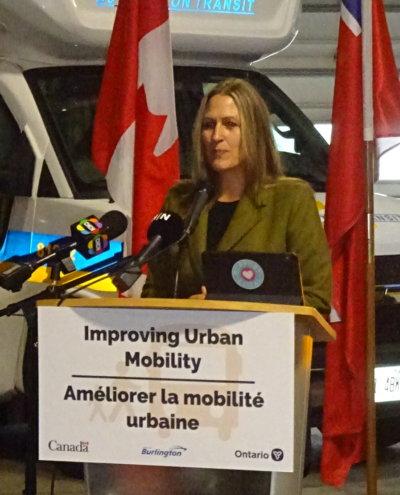 Mayor Meed Ward leading the announcement of new transit equipment. She had them dancing about the funding before they all went home. Thus the decision to lay millions of dollars on the city is something that was worked out between the federal government, the province and the city. The Region had nothing to do with this one.
The question that popped into my mind was: What does this mean to any electrification of the Burlington Transit fleet.
Every bit of professional advice Director of Transit Sue Connor got was that it was not possible to operate a fleet that was electric AND diesel. Not with the money that is available to Burlington transit. Everything about electric is different.
You have to go all in if you are going electric.
The charging stations needed to ensure that the bus batteries don’t fail are a million dollars each. It looked as if Burlington was going to need two of them.
Also on the table was the use of nitrogen as the propellant. There is a very strong argument for nitrogen over electricity.
 Director of Transit Sue Connor Sue Connor brought in a speaker who took council through the nitrogen argument explaining that Canada was at that time a bit of a leader in applying the use of nitrogen to transit.
Adding 12 diesel buses to the fleet does help Connor in meeting the demand that she hopes will come back.
Just before the covid shutdown took place transit was reporting double digit rider increases.
How quickly that ridership returns is an unknown at this point.
The 12 new 40 foot buses and the five conventional buses to replace vehicles in the fleet now are to be acquired over a three year period.
Perhaps Connors can hold getting those buses and make them electric when she does purchase.
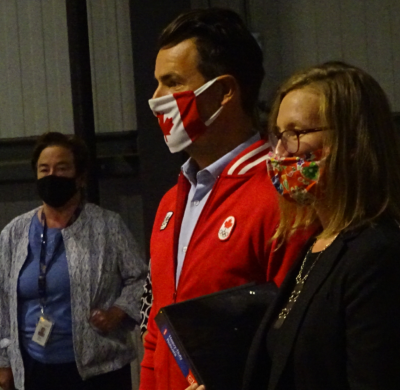 Director of Transit Sue Connor looks on while the political set announce that she is going to get 17 new buses over a three year time frame. None were to be electric – does this kill her dream of an all electric transit fleet? When Sue Connor was brought on board she made big changes at transit. There are people on staff there now who moved from other city departments to work at transit.
Connors has made the necessary changes; prior to her arrival there was some pretty incompetent leadership.
At one point a former Director of Transit had suggested that the terminal on John Street be closed and that bus tickets be bought at city hall (which closed at 4:30) or at local convenience stores around the city.
Problem was none of the convenience stores wanted to be bothered.
A lot of really stupid decisions were made before Connors took the wheel. Let’s hope that the senior levels of government that made the funds available have not killed the idea of an electric fleet for Burlington Transit.
Salt with Pepper is the musings, reflections and opinions of the publisher of the Burlington Gazette, an online newspaper that was formed in 2010 and is a member of the National Newsmedia Council.
What makes politicians dance: a funding announcement. Watch them do it.


 By Ray Rivers By Ray Rivers
August 23rd, 2020
BURLINGTON, ON
Did you know that Germans are now able to buy a brand new Renault electric vehicle (EV) for the cost of a cell phone contract?
 Germany has gone further than most countries to promote the use of electric vehicles. The Renault can be had for the equivalent of a cell phone contract. Yes, new EV subsidies there almost completely cover the cost of a new economy car, providing it’s of the plug-in variety. Europeans have always taken climate change seriously and are more prepared to take action than the rest of us – but even they are not doing nearly enough.
We, the people on this planet earth, keep breaking records on just how much climate warming pollution we generate.
2019 hit a new record, pumping 36.8 billion metric tons (gigatonnes) of carbon dioxide into the atmosphere. Thirty-six gigatonnes (Gt) ! It’s like we are in a competition to see how fast we can waste the planet.
To put that into context, if we took all the land mammals on the planet and put them on a scale they’d weigh one whole gigatonne. It is estimated that the entire human race together would weigh less than half a Gt. So that’s a lot of carbon pollution and it has led to a higher concentration in the atmosphere than at any point in at least the past 800,000 years.
The thermometer in Baghdad soared to 50 degrees C the other day. That’s 125 F, which is the ‘keep warm’ setting on my kitchen oven. And whether you measure it in Fahrenheit or Celsius America’s Death Valley won the title of hottest place on earth at 130 degree F (56 degrees C). And as you should expect, mother earth is responding to these carbon emissions even faster than anyone predicted.
 One of the largest ice packs on the planet. One of the largest ice packs on the planet, Greenland’s ice shelf, has passed the tipping point and is irreversibly melting faster than you can shake a stick. Combined with the rapidly increased melting of ice in the Antarctic, Canada and Russia, the US Geologic Survey, estimated that the world’s oceans could eventually rise 70 metres (230 feet) in a bunch of years. 70 metres is like 45 people standing one on top of each other.
The land below and adjacent to the ice caps is called permafrost, because it never used to thaw. Sealed in by frozen ground for millennia, since the last ice age, there are all kinds of treasures buried there, including some more very ancient viruses. There is also a lot of methane, the stuff you burn in your furnace. It’s from very old decayed vegetation.
It is estimated that there could be 1400 gigatonnes of carbon locked up as methane under the Arctic submarine permafrost alone. Methane is something like 32 times more powerful as a greenhouse gas than CO2. So if the scientists are right about potentially releasing those 1400 Gt of methane – do the math – we’re in for one helluva a party. And did I mention there is even more permafrost thawing on the land in northern Canada and Russia?
Further, scientists are now connecting global warming to a puzzling shift of the earth’s axis. Over the last 20 years there has been an increasing drift of the north pole away from Santa’s workshop in Canada’s north. That can be attributed to the melting of Greenland’s ice sheets. Greenland has been losing over 200 gigatonnes of ice a year since 2000 increasing the volumes in the oceans in the process. Meanwhile Antarctica has also lost over 90 gigatonnes.
 Will the changing climate have an impact on the earth’s axis – and if it does what impact will a change in that axis have on the lives we live? As the weight of the ice lifts off Greenland the poles start to migrate. It is uncertain what all this means for us planetary inhabitants, aside from our GPS devices needing some kind of updating, and poor Santa of course. But weather patterns will no doubt be heavily impacted as the rotation of the planet is affected.
So the impacts of warming the planet are not just about more flooding, more violent storms, more droughts and more massive forest fires, which in turn just add more carbon into the atmosphere.
COVID-19 might be the most immediate crisis before us now but global warming is the greatest existential threat we face. Yet we’ve all known about climate change for at least four decades and have failed to seriously respond to this growing crisis – a crisis which will be far more deadly than COVID-19.
An EV in every household Is a good start. And Germany is not the first jurisdiction to offer carrots instead of sticks to get their citizens to curb their carbon footprint. About half of the cars sold in Norway are fully electric, for example.
Ontario’s last government also offered generous EV subsidies. They started building a viable carbon-free electrical system, a viable carbon emission trading program and so much more. But we the voters clearly didn’t care about all that. Instead we voted in a government that clearly doesn’t get global warming, and has done it’s best to tear down all of those efforts.
Next time we’ll address why this is happening.
Meanwhile please join the discussion. As we said, perhaps too often, going into COVID – we’re all in this together as well.
 Ray Rivers, born in Ontario earned an economics degree at the University of Western Ontario and a Master’s degree in economics at the University of Ottawa. His 25 year stint with the federal government included time with Environment, Fisheries and Oceans, Agriculture and the Post office. Rivers is active in his community; he formed the first Sustainability Committee in Burlington. Ray Rivers, born in Ontario earned an economics degree at the University of Western Ontario and a Master’s degree in economics at the University of Ottawa. His 25 year stint with the federal government included time with Environment, Fisheries and Oceans, Agriculture and the Post office. Rivers is active in his community; he formed the first Sustainability Committee in Burlington.
Background links:
Iraq Oven Temp – Hottest Temp Ever – 2019 Record
Canada Last Ice – Europeans – Free Car –
Greenland Ice – Earth’s Axis – Permafrost –

 By Pepper Parr By Pepper Parr
August 15th, 2020
BURLINGTON, ON
City Council ended a long work day on Thursday – starting at 9:30 am and adjourning at just after 10 pm that night.
They started out as a Standing Committee, rolled it over into a Meeting of Council and passed a number of significant bylaws.
There was an interesting debate on plans to create a Registry within which members of Council would let the public know who they have been meeting with.
Politicians at every level don’t particularly like Registry’s. Ward 2 Councillor Lisa Kearns has had one in place for some time. She brought forward a Motion asking that there be a Registry that included every member of Council
During the debate Mayor Marianne Meed Ward said she has had a Register since the day she became Mayor.
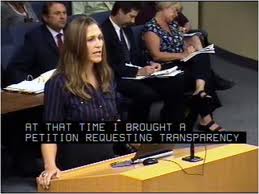 Transparency was Meed Ward’s operative word before she was even elected to office. That was a surprise to me – it was something I had never heard of before. With Mayor Meed Ward everything she does that is new and different is mentioned often. She sees and positions herself as a politician who is going to do things differently. She used the words accountability and transparency every time she delegated at Council as a citizen.
The Gazette reached out to the Mayor’s Communication staffer. Got a message that he was working from home. Our message to the Communications Staffer was:
At the Standing Committee last night the Mayor said that she keeps a record of everyone she meets with along with minutes of the meeting and that that information is publicly available.
Can you tell me where that information is located?
Thank you
Shortly after we got an email from Suzanne Vukosavljevic, Manager of Communications, City Manager’s Office. We did not reach out to Vukosavljevic – she appears to have been advised by the Mayor’s Communications Staffer that the Gazette was asking questions.
She responded:
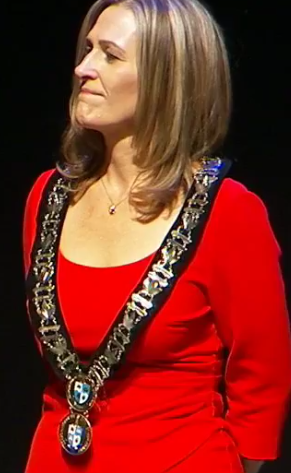 Marianne Meed Ward after being sworn in as Mayor of Burlington The Mayor’s Office maintains a record of meetings with developers, with minutes. They are not online but, as stated, available to the public upon request and can forward.
We responded asking for a link to the information.
Vukosavljevic replied:
Good afternoon Pepper,
The Mayor’s Office maintains a record of meetings with developers, with minutes. If there is interest in a particular meeting, we can forward those minutes. The only meetings that have taken place this year have been:
- Clearview – Adam Peaker, June 29
- Millcroft Golf Course – Frank Bon, Feb 6
Thanks, Suzanne
That is not quite good enough. Where are the records? Written up in a little black book? Are they in a place where they can be accessed by people in the Mayor’s Office and changed?
During the debate the Mayor said the information was public and that it was online.
That isn’t the case. It certainly isn’t transparent.
Politicians are judged by what they do – not what they say.
We applaud the Mayor recording her meetings and keeping minutes.
We would like to see the complete record of every meeting along with the minutes. The public has a right to see everything not just what City Hall functionaries decide to make available.
In a conversation with a former Mayor of the City he said that anyone who wants to do something in the City meets with the Mayor. “It all comes through the Mayor’s office” he said.
Of course it does and the Gazette wants a mayor who preaches accountability and transparency to practice what she preaches.
Salt with Pepper is the musings, reflections and opinions of the publisher of the Burlington Gazette, an online newspaper that was formed in 2010 and is a member of the National Newsmedia Council.

 By Pepper Parr By Pepper Parr
August 15th, 2020
BURLINGTON, ON
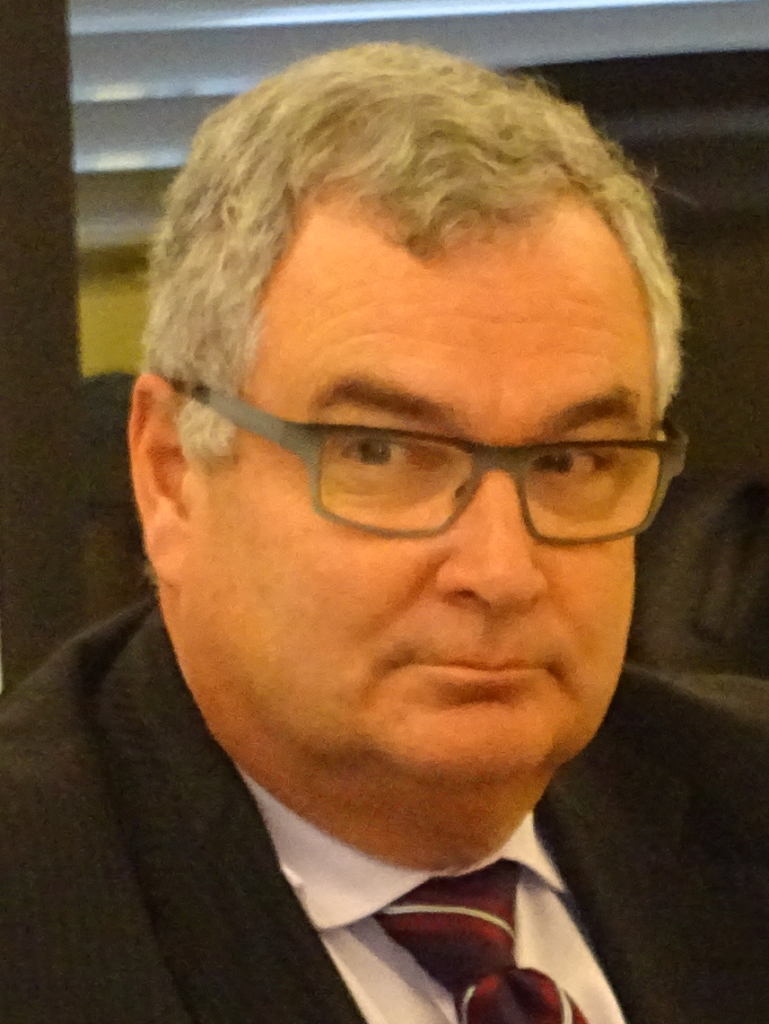 He can’t seem to stay away from the City. He can’t seem to stay away from the City.
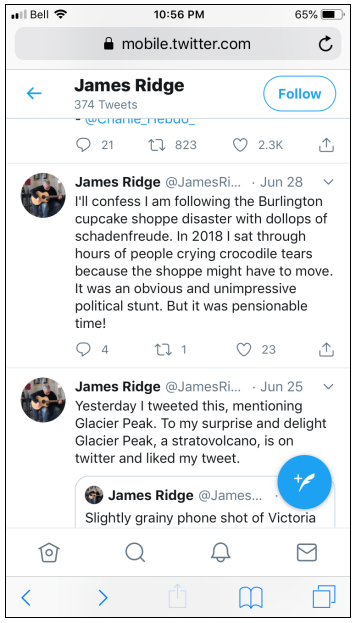 One of the first things Marianne Meed Ward did once she had the Chain of Office around her neck was to call a meeting of her newly sworn in members of Council and went into a Closed session where Council agreed that the City Manager was to be shown the door – dismissed – fired is the word people like to use. One of the first things Marianne Meed Ward did once she had the Chain of Office around her neck was to call a meeting of her newly sworn in members of Council and went into a Closed session where Council agreed that the City Manager was to be shown the door – dismissed – fired is the word people like to use.
There was never any word on what it actually cost the city to dismiss James Ridge – but it wasn’t cheap.
The city would have had to buy out the balance of his contract, cover the cost of moving him out of Burlington and probably something for perceived pain and suffering on the part of Ridge.
In the municipal world, at the City Manager level – these things happen – you take your lumps and move on.
Ridge cleared his desk on either Tuesday December 4th or the 5th. He knew it was coming. He had said to one of the security people before the election that “If she wins I am toast”. Since his departure Ridge has tweeted frequently on Burlington events.
A June 28th tweet has a number of people in Burlington very disturbed. One reader of the tweet commented “We knew it all the time”.
Ridge commented on how many people in the city voiced their concern over the possible demise of a very popular commercial location. Commenting the way he did can only be seen as very unprofessional.
The words that galled people were Ridge saying it was “pensionable time!”
That’s more than unprofessional – that’s just plain crass.

 By Pepper Parr By Pepper Parr
August 12th, 2020
BURLINGTON, ON
It was pathetic.
The media release was from the Office of the Mayor. She was exited about the change in the name of a committee that is part of AMO – Association of Municipalities in Ontario,
Mayor Marianne Meed Ward was acclaimed recently as a member of LUMCO – Large Urban Mayors’ Caucus of Ontario
They recently changed their named to Ontario’s Big City Mayors and that was important enough to put out a media release.
Really?
“LUMCO is excited to announce its new name: Ontario’s Big City Mayors (OBCM). While the name has changed, our mission remains the same: to represent the interests of Ontario’s 29 biggest cities, and almost 70% of Ontarians, through public policy development, advocacy and discussion.
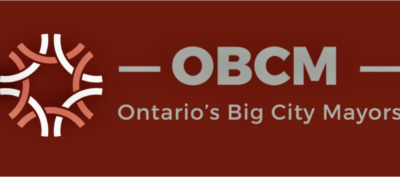 “Ontario’s Big City Mayors (OBCM) is comprised of mayors of Ontario cities with populations of 100,000 or more. “Ontario’s Big City Mayors (OBCM) is comprised of mayors of Ontario cities with populations of 100,000 or more.
“OBCM provides a voice for big city mayors in policy debates that impact Ontario cities. Through policy development, advocacy, discussion and partnerships, Ontario’s Big City Mayors support strong and effective cities.”
The Mayor and two of her Council members did themselves proud earlier this week last week when they “took a knee” at the Black Lives Matter graphic painted on the sidewalk outside city hall.
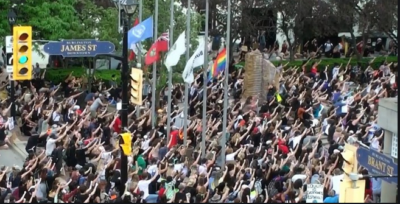 Thousands of young people marched on city hall to show their support for the Black Lives Matter movement. 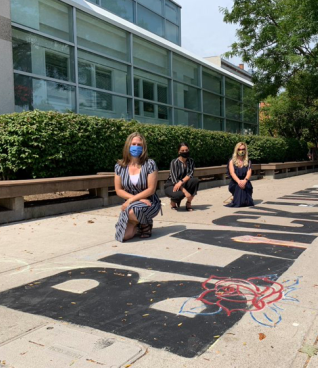 The Mayor and two Councillors did the “taking a knee” gesture beside the Black Lives Matter outside city hall. The graphic had relevance – especially after the march of several thousand people who demonstrated outside city hall a number of months ago.
But “taking a knee”? That is a gesture we see at sports events in the United States where people of colour in the sports sector have been poorly treated for decades.
“Taking a knee” in that venue makes sense and has an impact.
In Burlington a passer-by might well ask: ‘What are they doing’?

 By Pepper Parr By Pepper Parr
August 6th, 2020
BURLINGTON, ON
Hospitals – vital and expensive.
Burlington has had an, at times, awkward relationship to the Joseph Brant Hospital.
It took a long time to get the provincial funding for the upgrade of the older parts of the building and the construction of the new wing.
Former Mayor Rick Goldring got a bit of a shock when he was told by the province that the city was going to have to come up with a large part of the construction cost.
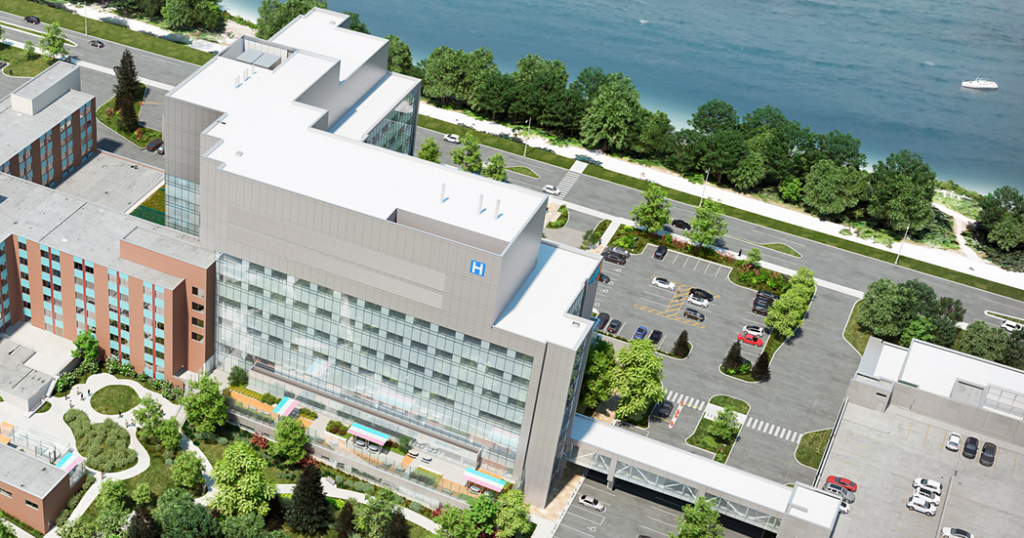 A special tax levy was required to pay for the city’s portion of the hospital – which taxpayers willingly paid. The amount was so big that the city had to impose a special tax levy to raise the funds – and the public willingly paid that additional tax levy.
The city then found a way to roll that tax levy over into a source of funds for other needed service. The public wasn’t as happy with that little tax trick.
One would have thought the city council at the time would have at least asked – truth be told they really didn’t even come out and tell the taxpayers what they were doing – they just did it.
The Gazette was also the news source that dug out many of the facts relating to the c-dificile tragedy at the hospital that resulted in the deaths of at least 80 people.
Yesterday we published a piece on the experience of two people at different area hospitals: The Joseph Brant, where a woman had an appointment and how she was treated. Then in the same piece, about a male who had an appointment at the St. Joseph’s Hospital in Hamilton.
Two very different experiences.
We expect a strong reaction to that article and be accused of picking on the Joseph Brant Hospital. What we were doing was pointing out the different cultural base from which each hospital works.
St. Joseph’s was formed by the Sisters of St. Joseph: nuns who brought a different touch to patient needs.
Burlington’s Joseph Brant doesn’t have that deep historical cultural commitment that is needed. That culture can be grown – the leadership at the hospital has to show by example how patient care can be done differently.
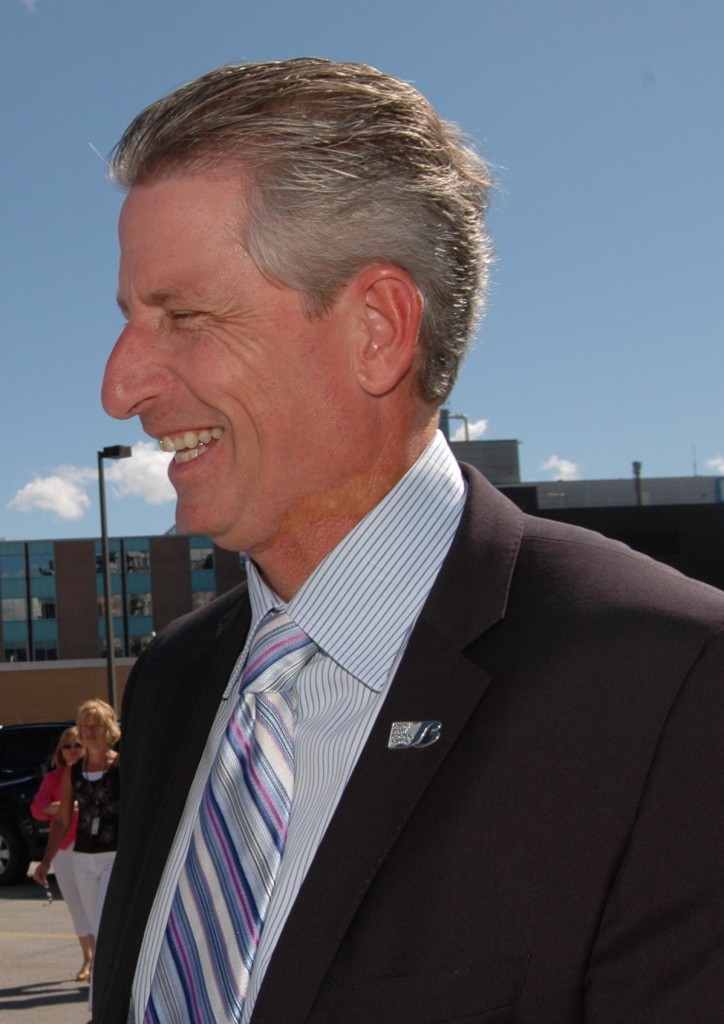 Joseph Brant Memorial Hospital CEO Eric Vandewall. The Joseph Brant has done some very fine medicine. Eric Vandewall ensured that the renovation and new build was done close to perfect.
 It was a high end field hospital that went up very quickly – hasn’t been used – yet. He made the brave decision to spend $2 million on a facility that could be used for any over flow of COVID-19 patients.
The space has not had to be used – yet.
Some will suggest that was $2 million wasted. It wasn’t wasted. Vandewall did what he believed was a prudent decision and we don’t think he was wrong.
 Telling us how they feel about their hospital. Burlington has thousands of people who willingly put up a sign on their lawn declaring how much they love their hospital. Nothing wrong with solid civic pride.
What we would like to see is the evolution of a different culture that has people experiencing the care and concern that one person experienced at St. Joseph’s in Hamilton and not the experience a woman had at Joseph Brant.
It can be done but it won’t be done until someone at a very senior level makes the change a personal mission.
Related news stories:
The cute tax trick with the hospital tax levy.
Two different patient experiences

|
|
 By Pepper Parr
By Pepper Parr

















 This may be a chain of commercial restaurants but it doesn’t compromise when it comes to quality food and flavours. The decor is trendy and lighting is low for a stylish, yet inviting setting.
This may be a chain of commercial restaurants but it doesn’t compromise when it comes to quality food and flavours. The decor is trendy and lighting is low for a stylish, yet inviting setting.



 Michele Bogle is a Burlington resident who writes for the Gazette on community issues. Ms Bogle has taken part in the Food Network for the second year in a row to audition for the ‘Great Chocolate Showdown’ 2020 and 2021. She made it to the second stage of auditions for ‘Wall of Chefs’ 2019 and finished top 1% of auditions last year for ‘The Great Canadian Baking Show’.
Michele Bogle is a Burlington resident who writes for the Gazette on community issues. Ms Bogle has taken part in the Food Network for the second year in a row to audition for the ‘Great Chocolate Showdown’ 2020 and 2021. She made it to the second stage of auditions for ‘Wall of Chefs’ 2019 and finished top 1% of auditions last year for ‘The Great Canadian Baking Show’. Without going into an extended history lesson on Neapolitan Cuisine, suffice it to note that its cuisine took much from the culinary traditions of Naples, Italy; reaching a balance between dishes based on rural ingredients (pasta, vegetables, cheese) and seafood dishes (fish, crustaceans, mollusks). Fortunately for us this tradition was brought to our very own Village Square by the Paradiso Restaurant Group in 2003, after great success opening the first Paradiso Restaurant in Oakville, in 1993. This Mediterranean gem has impressed guests since its inception. Tripadvisor rates it #10 out of more than 300 restaurants in Burlington and snagged a #2 spot on the top 10 best Italian restaurants in Burlington, by Yelp.
Without going into an extended history lesson on Neapolitan Cuisine, suffice it to note that its cuisine took much from the culinary traditions of Naples, Italy; reaching a balance between dishes based on rural ingredients (pasta, vegetables, cheese) and seafood dishes (fish, crustaceans, mollusks). Fortunately for us this tradition was brought to our very own Village Square by the Paradiso Restaurant Group in 2003, after great success opening the first Paradiso Restaurant in Oakville, in 1993. This Mediterranean gem has impressed guests since its inception. Tripadvisor rates it #10 out of more than 300 restaurants in Burlington and snagged a #2 spot on the top 10 best Italian restaurants in Burlington, by Yelp.





 Ray Rivers, born in Ontario earned an economics degree at the University of Western Ontario and a Master’s degree in economics at the University of Ottawa. His 25 year stint with the federal government included time with Environment, Fisheries and Oceans, Agriculture and the Post office. Rivers is active in his community,
Ray Rivers, born in Ontario earned an economics degree at the University of Western Ontario and a Master’s degree in economics at the University of Ottawa. His 25 year stint with the federal government included time with Environment, Fisheries and Oceans, Agriculture and the Post office. Rivers is active in his community,






































 Ray Rivers, born in Ontario earned an economics degree at the University of Western Ontario and a Master’s degree in economics at the University of Ottawa. His 25 year stint with the federal government included time with Environment, Fisheries and Oceans, Agriculture and the Post office. Rivers is active in his community; he formed the first
Ray Rivers, born in Ontario earned an economics degree at the University of Western Ontario and a Master’s degree in economics at the University of Ottawa. His 25 year stint with the federal government included time with Environment, Fisheries and Oceans, Agriculture and the Post office. Rivers is active in his community; he formed the first 


 He can’t seem to stay away from the City.
He can’t seem to stay away from the City. One of the first things Marianne Meed Ward did once she had the Chain of Office around her neck was to call a meeting of her newly sworn in members of Council and went into a Closed session where Council agreed that the City Manager was to be shown the door – dismissed – fired is the word people like to use.
One of the first things Marianne Meed Ward did once she had the Chain of Office around her neck was to call a meeting of her newly sworn in members of Council and went into a Closed session where Council agreed that the City Manager was to be shown the door – dismissed – fired is the word people like to use. “Ontario’s Big City Mayors (OBCM) is comprised of mayors of Ontario cities with populations of 100,000 or more.
“Ontario’s Big City Mayors (OBCM) is comprised of mayors of Ontario cities with populations of 100,000 or more.






